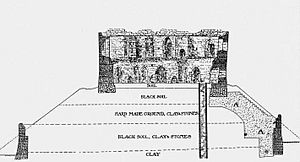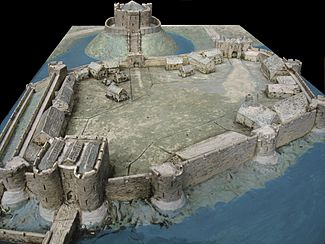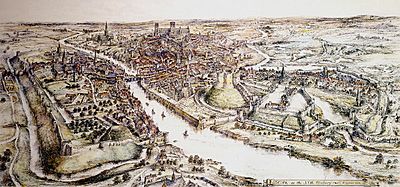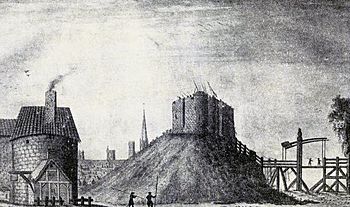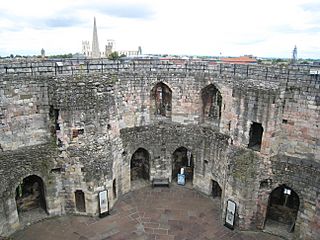York Castle facts for kids
Quick facts for kids York Castle |
|
|---|---|
| Yorkshire, England | |
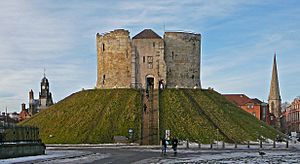
Clifford's Tower, the keep of York Castle
|
|
|
Shown within North Yorkshire
|
|
| Coordinates | 53°57′21″N 01°04′48″W / 53.95583°N 1.08000°W |
| Type | Shell keep and bailey |
| Site information | |
| Owner | English Heritage, York Museums Trust, Her Majesty's Courts Service |
| Condition | Ruined keep, restored part curtain-wall, surviving 18th century buildings used as a museum and York's Crown Court |
| Site history | |
| Materials | Magnesian Limestone |
| Battles/wars | Siege of York in 1644 |
| Events | Jewish massacre of 1190 |
|
Listed Building – Grade I
|
|
| Designated | 14 June 1954 |
| Reference no. | 1259325 1259360 1259324 1259328 1259329 |
York Castle is a historic site in the city of York, England. It has been many things over the last 900 years. It started as a strong castle, then became a prison and law courts. Today, parts of it are a museum and still a court.
The most famous part of York Castle is its ruined keep, known as Clifford's Tower. This tower was originally built by William the Conqueror to control the city of York, which used to be a Viking settlement. The castle had a difficult early history, but it grew into a major fortress with strong water defences. After a big explosion in 1684, the military parts of the castle were no longer used. However, it continued to be a prison until 1929.
The first castle here was a motte and bailey castle, built in 1068 after the Normans took over York. It was destroyed by rebels and a Viking army in 1069. But York Castle was quickly rebuilt and made stronger with moats and an artificial lake. It became a very important royal fortress in northern England.
In 1190, a terrible event happened when about 150 local Jewish people were killed in the wooden castle keep. Later, King Henry III rebuilt the castle in stone in the mid-1200s. He created a unique quatrefoil (four-leaf shape) keep, which is Clifford's Tower today. During the wars with Scotland (1298-1338), York Castle was often the main place for the king's government in England. It was also a key military base.
By the 1400s and 1500s, York Castle started to fall apart. It was used more and more as a prison for criminals and political prisoners. By the time of Queen Elizabeth I, the castle had lost its military value. However, it was still kept as a symbol of royal power in York. When the English Civil War began in 1642, York Castle was repaired and made strong again. It played a role in the Royalist defence of York in 1644 against Parliamentary forces. The castle remained a military base until 1684, when an explosion destroyed the inside of Clifford's Tower.
In the 1700s, the castle's main courtyard was rebuilt in a new style. It became a centre for county government in Yorkshire and was used as a prison for criminals and people who owed money. In the 1800s, prison reform led to a new prison being built on the site in 1825. This prison was used first for the county and then as a military prison. It was pulled down in 1935. By the 1900s, the ruins of Clifford's Tower were a popular tourist spot and a national monument. Today, English Heritage owns the site, and it is open to visitors. The other old buildings are now the York Castle Museum and the Crown Court.
Contents
- History of York Castle
- Early Days: 11th Century
- Changes in the 12th Century
- Stone Castle and Royal Hub: 13th and 14th Centuries
- Decline and War: 15th and 16th Centuries
- Civil War and Explosion: 17th Century
- New Buildings and Prison Reforms: 18th Century
- Modern Prisons and Preservation: 19th Century
- Becoming a Monument: 20th Century
- York Castle Today
- See also
History of York Castle
Early Days: 11th Century
York was an important city in the 10th and 11th centuries, once a Viking capital. In 1068, William the Conqueror built his first castle in York. This was a simple wooden motte and bailey castle, located where York Castle stands today. It was built very quickly, possibly in just eight days. Hundreds of homes were destroyed to make space for it.
In 1069, William built a second castle on the other side of the River Ouse, at Baile Hill. This was also a wooden motte and bailey design. Later that year, a Danish Viking fleet attacked York. They were helped by local rebels. The Normans tried to fight back by setting fire to some city houses. The fire spread out of control, burning York Minster and possibly the castles too. Both castles were captured and partly destroyed.
After these attacks, William carried out harsh actions across northern England to restore order. This period was called the "Harrying of the North". It allowed the two castles to be rebuilt, again in wood. York Castle's main area was made a bit bigger. By 1086, the castle was surrounded by a water-filled moat and a large artificial lake called the King's Pool. This lake was fed by the River Foss using a dam. Over time, the Baile Hill castle was abandoned, leaving only its mound.
Changes in the 12th Century
King Henry II visited York Castle four times during his rule. The king's rooms were inside the keep for safety. Henry spent £15 on repairs to the keep. In 1175, he used the castle to receive William the Lion of Scotland. Mills were built nearby to support the castle's soldiers. The Knights Templar, a military order, owned these mills for a while. The mills often flooded and needed many repairs.
The 1190 Massacre of Jews
In 1190, York Castle was the site of a terrible event for the Jewish community in England. Jewish people had been brought to England by the Normans. Some worked as moneylenders, which was a necessary job that Christians were not allowed to do. Jewish communities faced a lot of prejudice. They often lived in towns with a royal castle, which could protect them from attacks. Kings usually protected them because Jewish property and debts owed to Jews belonged to the crown.
When Richard I became king in 1189, he announced he would join the Crusades. This made anti-Jewish feelings much worse. Rumours spread that the king had ordered attacks on English Jews. In York, violence broke out the next year. A man named Richard de Malbis, who owed money to a powerful Jewish merchant, used a house fire to stir up a mob. This mob attacked the home of a Jewish man who had recently died.
Josce of York, the leader of the Jewish community, led local Jewish families to the royal castle. They took shelter in the wooden keep. The mob surrounded the castle. When the constable (the castle's commander) left to talk, the Jewish people feared the mob would enter or they would be handed over. So, they refused to let him back in. The constable then asked the sheriff for help, and the sheriff's men laid siege to the keep.
The siege continued until March 16. The Jewish people could no longer hold out. Their religious leader, Rabbi Yomtob, suggested setting the castle on fire. Some Jewish people died in the flames, but most chose to take their own lives rather than surrender to the mob. A few did surrender, promising to become Christians, but the angry crowd killed them anyway. About 150 Jewish people died in this massacre. After this, the wooden keep was rebuilt on the mound, which was made 4 metres taller.
Stone Castle and Royal Hub: 13th and 14th Centuries
King John used York Castle a lot during his rule. He used the keep as his private living area for safety. The castle was kept in good condition. During this time, the castle was first used as a prison. Prisoners from John's wars in Ireland were held there. By the 1200s, there was a system where local lands were given in exchange for knights and archers to guard the castle.
In 1228, a strong storm destroyed the wooden keep on the mound. It was not repaired. Instead, a building for the king was built in the main castle area. In 1244, when the Scots threatened to invade England, King Henry III visited the castle. He ordered it to be rebuilt in white limestone. This work cost about £2,600 and happened between 1245 and 1270. It included new stone walls with towers, a large gatehouse with two towers, smaller gatehouses, a watergate, a small city gate, a chapel, and a new stone keep. This new keep was first called the King's Tower, and later Clifford's Tower.
Clifford's Tower has a very unusual design. It is a two-story tower with a quatrefoil (four-leaf) shape. Each of the four round parts is about 6.7 metres across. The walls are 2.9 metres thick. At its widest, the tower is about 24 metres across. A square gatehouse, 6.4 metres wide, protected the entrance. There were also small defensive towers between the round parts. The tower had special openings for firing arrows, unique to York Castle. A chapel was built over the entrance. This design was an experiment to allow defenders to see more ground from the top of the keep. It looks similar to a castle in France.
The new castle needed constant money to stay strong. Winter floods in 1315-16 damaged the base of the mound, needing quick repairs. Around 1358-60, the heavy stone keep started to sink again, and one of the round parts cracked from top to bottom. Officials suggested rebuilding it completely, but instead, it was repaired for £200.
Edward I gave the sheriff of Yorkshire great power to keep law and order in York. The sheriffs made Clifford's Tower their headquarters. During the wars against Scotland, York Castle was the main centre for the king's government in England for many years. Many government offices moved from London to York, setting up in the castle. The existing buildings were not enough, so new temporary buildings were put up. The Exchequer (the king's money office) took over Clifford's Tower. The castle even got its own mint in 1344 to make gold and silver coins for northern England.
Henry III also expanded the castle's role as a prison. The sheriff was in charge of the prison. Up to 310 prisoners were held at one time. Conditions for prisoners were very bad, and many died. Escapes were common. When the Knights Templar were arrested in 1307, many were held at York Castle. Edward II also used the castle to hold rebellious nobles in 1322. After the Battle of Boroughbridge, many rebel leaders were executed at York Castle.
By the end of the 1300s, the castle's main area was mostly used by local government. It was used a lot as a prison, with prisoners kept in the towers. The old system of guards was replaced by hiring local guards. Kings and their staff often preferred to stay in other buildings in York, not the castle itself.
Decline and War: 15th and 16th Centuries
In the 1400s, York Castle was seen as an important security spot in northern England. However, less money was spent on its upkeep. Repairs became rare from 1400 onwards, and the castle slowly fell apart. Richard III tried to fix some of the worst parts in 1483, but he died before the work could start. By the time of Henry VIII, the castle was in very bad condition. Still, its water defences were still working. Because of the damage, the king's advisors had no official place to stay in York. The castle mint closed in 1553. The castle mills were given to a hospital in 1464, but later became private property.
The castle continued to be used as a prison, mostly for local criminals. It was also a place for political executions. By the 1500s, it became common to hang traitors from the top of Clifford's Tower. For example, in 1536, Robert Aske was executed at York Castle. This happened after his protest against the king, called the Pilgrimage of Grace, failed. For most of this time, the sheriffs of Yorkshire controlled the castle. However, the Clifford family became the hereditary commanders of the castle later in the 1500s. Clifford's Tower got its name from this family around that time.
The castle kept getting worse during the reign of Queen Elizabeth I. She was told it had no military use left. The tower keeper, Robert Redhead, became known for taking parts of the castle apart and selling the stone for his own gain. Despite efforts to stop him, Redhead caused a lot of damage. There were plans to pull down Clifford's Tower completely in 1596, but strong local feelings saved it.
Civil War and Explosion: 17th Century
Keeping the castle in good repair was very expensive. In 1614, King James I sold the lease for Clifford's Tower and the land around it to two property investors. They then sold Clifford's Tower to a merchant family in York. However, in 1642, the English Civil War began. Forces loyal to Charles I, led by Henry Clifford, took control of York Castle and the city in 1643. York became the "northern capital" for the king's side. Clifford repaired the castle and made the walls strong enough for cannon. The gatehouse of Clifford's Tower was greatly changed. A hill on the other side of the river, Baile Hill, became a place for guns. The castle mint was reopened to make coins for the king's army.
The war turned against the Royalists. On April 23, 1644, Parliamentary forces began the siege of York. Armies from Scotland and Parliament surrounded the city. Six weeks later, a third army arrived, bringing the total number of attackers to over 30,000 men. William Cavendish commanded the city during the siege, and Colonel Sir Francis Cobb was the castle governor. Despite attacks and attempts to dig under the walls, the city held out. Prince Rupert arrived with more soldiers and forced the attackers to leave on July 1. The next day, Parliamentary forces defeated Rupert at the Battle of Marston Moor, near York. This made it clear that York and the castle would have to surrender. On July 14, the city and castle gave up to the Parliamentary forces.
Parliament then made Thomas Dickenson, the local mayor, the governor of Clifford's Tower. The mayor controlled the castle until the king returned to power. Efforts were made to keep Clifford's Tower, used by soldiers, separate from the main castle area, which was still a prison. Oliver Cromwell visited Clifford's Tower in 1650. The city of York had to pay for the soldiers stationed there.
After Charles II became king again, the people who owned Clifford's Tower before the war got it back. However, soldiers were still stationed there, so the owners could not use it. Repairs were made, and the tower became a place to store gunpowder and cannonballs. They also tried to fix the moat, which had filled with dirt. Some political prisoners were still held at the castle, including George Fox, who started the Society of Friends.
The county buildings in the main castle area were improved. But by the 1680s, people questioned why soldiers were still at York Castle. A report in 1682 said it would cost at least £30,000 to make the castle a modern fortress. This work was never done. Also, the soldiers and the castle had become very unpopular with the people of York.
On April 23, 1684, around 10 PM, an explosion in the gunpowder storage area completely destroyed the inside of Clifford's Tower. The official story was that a celebratory gun salute set fire to wood, which then ignited the gunpowder. However, most historians believe the explosion was not an accident. People in the city often joked about wanting the "Minced Pie" (as they called the castle) to be destroyed. Suspiciously, some soldiers had moved their belongings to safety just before the explosion, and no one from the army was hurt. The heat from the fire turned the tower's limestone its current slightly pink colour. The ruined tower was then fully returned to private ownership.
New Buildings and Prison Reforms: 18th Century
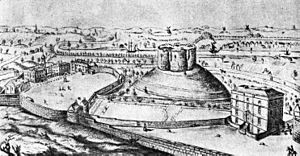
By 1701, the conditions in the county prison were very bad. So, it was decided to rebuild the old main castle area. A local tax helped pay for this. The king also allowed stones from the ruins of St Mary's Abbey to be used for building. Three new buildings were put up south of Clifford's Tower. A new county prison was built between 1701 and 1705.
Later, a local architect named John Carr built the Assize Courts (law courts) between 1773 and 1777. He also oversaw the replacement of other buildings with the Female Prison between 1780 and 1783. The Female Prison and county prison were later combined into the Debtors' Prison. Both of Carr's buildings were designed in a neoclassical style, which was popular at the time. The Assize Court building was especially praised as a "superb building." The castle courtyard was covered with grass in 1777 and became known as the "Eye of the Ridings." It was used for electing members of parliament for York.
The prison reformer John Howard visited these prisons for his book The State of the Prisons. He found them to have problems, but they were in relatively good condition compared to others at the time. The Debtors' Prison was considered "an honour to the county" with "airy and healthy" rooms. However, the part for criminals was criticized. It was "too small" and had "no water" for the prisoners. Criminals had to sleep on straw on the floor. Conditions were so bad that nine prisoners died from suffocation in one night in 1739.
Outside the main walls, the castle mills became less useful in the 1500s because the rivers driving them had less water. In 1778, they were rebuilt with a new steam engine. This engine caused a lot of smoke and noise, which bothered the prisoners.
Modern Prisons and Preservation: 19th Century
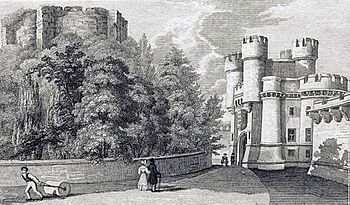
Criticism of the castle prison grew in the late 1700s. The facilities were not good enough. Also, large crowds gathered outside the prison to watch prisoners being taken for execution, which was seen as improper. From 1803, executions were moved to the former castle courtyard, the Eye of the Ridings. But crowds still gathered outside. By 1813, a faster method of hanging was introduced. This allowed for the quick execution of fourteen Luddite protestors at the castle in 1814. Overcrowding was also a problem, with up to 114 prisoners at a time. Sometimes, about forty prisoners waiting for trial had to stay in the jail yard because there was no other space.
The prison's problems came to a head in 1821, leading to an official complaint and investigation. It was decided to buy Clifford's Tower and the nearby Waud house. The plan was to pull them down to make space for a new, modern prison. However, Sydney Smith, a famous writer, successfully led a campaign to save Clifford's Tower. He stressed its historical importance to the city. Another idea was to turn Clifford's Tower into a habitable building as the centre of a new prison design, but this was rejected.
In 1825, Clifford's Tower and the Waud house were bought by the county of Yorkshire for £8,800. The new prison buildings were designed in a Tudor Gothic style. They included a gatehouse 10.7 metres high and a prison block with wings spreading out like spokes on a wheel. It was protected by a long, high stone wall. The prison was considered the strongest in England. It was built entirely of dark grey gritstone to be secure and fireproof, giving it a forbidding look. However, the prison itself was thought to be healthy and well-ventilated.
Clifford's Tower was not part of the new prison's design. But the sloping base of its mound was cut away and replaced by a wall to make more space. The backyard of the Female Prison was used for hangings from 1868 onwards.
The Prison Act 1877 changed the English prison system. York Castle prison came under central government control the next year. It was used as the county prison until 1900. Then, prisoners were moved to Wakefield Prison. After that, the facility was used as a military prison.
By the early 1800s, improvements to the River Foss made it easier to bring flour into York by river. This made the castle mills less important. In 1856, the castle mills were finally pulled down as part of more river improvements. The King's Pool, part of the castle's water defences, was drained. With new bridges built near the castle, the site became "surrounded by roads instead of moats." Some important trials took place at the Assize Courts (now Crown Court) building in the 1800s.
Becoming a Monument: 20th Century
In 1890, the Prison Commissioners agreed to declare Clifford's Tower a national monument. They wanted to protect it as a historic place. In 1902, Clifford's Tower was given to the York Corporation. They also received a grant of £3,000 for its care and repairs. The earlier removal of the sloping base and damage to the stonework had put too much pressure on the supporting mound. This caused the sinking problem from the 1300s to return. Sir Basil Mott, a leading engineer, installed concrete supports to make the structure stable under the gatehouse. By the early 1900s, Clifford's Tower was regularly open to visitors. In 1915, it was passed to the Office of Works as a national monument.
York Castle Today
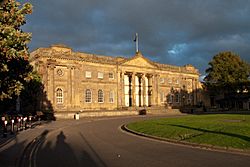

York Prison finally closed in 1929. The Tudor Gothic Victorian prison buildings were pulled down in 1935. The Assize Courts building now holds the York Crown Court. The former Debtors' Prison and Female Prison, along with a modern entrance, are now the Castle Museum. The circular grassy area between these buildings, once called the "Eye of the Ridings," is now known as Castle Green or the "Eye of York." Clifford's Tower is the most noticeable remaining part of the original medieval castle. However, the stone steps up the side of the mound are modern. Small pieces of the main castle wall, parts of the south gatehouse, and one of the corner towers also still exist.
The castle is listed as a Grade I listed building and a Scheduled monument. English Heritage manages the site, and it is open to the public. Until the 1970s, the terrible event of 1190 was often not mentioned in official histories of the castle. Early official guides did not refer to it. However, in 1978, the first memorial tablet to the victims was placed at the base of Clifford's Tower. In 1990, the 800th anniversary of the killings was remembered at the tower.
Recently, some businesses wanted to build shops around the area. Citizens, visitors, experts, environmental groups, local business people, and Jewish groups have opposed this. They had some success, winning a long public inquiry in 2003.
In March 2022, English Heritage finished a project to preserve the tower. This included work on the limestone and the chapel roof. New wooden stairways inside the tower lead to a new roof deck. This allows visitors to see original features up close and enjoy less crowded views over the city.
|
See also
 In Spanish: Castillo de York para niños
In Spanish: Castillo de York para niños



